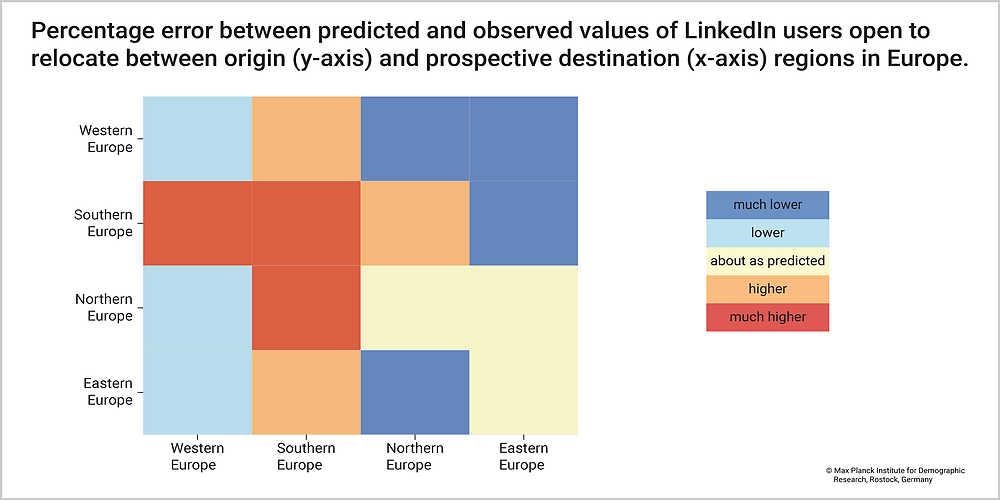June 22, 2022 | Press Release
LinkedIn Data Shed Light on the Openness to Migrate Internationally for a Job

© iStockphoto.com/OhmZ
In their recent study MPIDR Researcher Daniela Perrotta and co-authors show how a novel LinkedIn dataset can be used to characterize international migration aspirations in Europe. They find that in absolute terms, countries in Northern and Western Europe are the most attractive ones for potential migrants. But in terms of relative attractiveness - quantified by means of a gravity-type model - Southern Europe appears to be more attractive.
“In this work we unveil a novel LinkedIn dataset as a proxy for studying migration aspirations of professionals in Europe”, says Daniela Perrotta, Research Scientist at the Max Planck Institute for Demographic Research (MPIDR) in Rostock, Germany. Looking solely at descriptive statistics, Daniela and her co-authors found that countries in Northern and Western Europe are the most attractive ones in terms of potential future migration: About 60% of LinkedIn users open to work-related relocation would consider these regions as a prospective job location. On the other hand, about 40% would be open to move to Southern Europe and only 30% would consider countries in Eastern Europe. In addition to the overall migration potentials, the researchers also observed substantial heterogeneity in directionality of aspirations: for example, roughly 20% of LinkedIn users would relocate from Western to Northern Europe, while less than 10% would relocate from Northern to Western Europe.
To assess the relative attractiveness between countries, the researchers then employed a gravity-type model as a form of standardization to account for a number of biases in the data, including differences in population density, geographic and linguistic distances, and internet and LinkedIn penetration. The researchers observed that, while Eastern Europe remains a relatively unattractive destination, Southern Europe appears to be a highly desired destination for professionals. This indicates that there is potential for changing patterns in actual flows, in case more opportunities for professionals arise in Southern Europe.
Study contributes to reducing the data gap in migration potentials
“When looking solely at the LinkedIn data the openness to work-related relocation to Southern Europe is quite small, but after accounting for key factors included in the gravity model, Southern Europe appears to be a highly desired destination in relative terms”, says Daniela Perrotta.

Each cell is colored based on the quintile of the percentage error, ranging from observed values much lower than predicted (in blue) to observed values much higher than predicted (in red). © MPIDR
Download Figure (PNG File, 173 kB)
The data were collected via the LinkedIn Recruiter platform, which is part of LinkedIn, a professional networking site of nearly 800 million users. “While its main purpose is to enable professional recruiting by searching through profile attributes of potential job candidates, in our work we leveraged this feature to capture work-related international migration patterns in Europe”, says Daniela Perrotta. Specifically, this refers to those LinkedIn users who have indicated in their profiles that they are open to finding a new job, and have listed one or more prospective job locations that differ from where they are currently located.
Compared to traditional survey data, the LinkedIn data employed in this study offer the advantage of being continuously available, consistently defined across countries and languages, and provide a global and recent snapshot of openness to migration. Of course, these data also come with some limitations and challenges stemming from the type of platform and the way it is designed. “However, exploring alternative data sources to characterize potential future migration flows and their key drivers is of paramount importance to complementing traditional research methods and informing policy makers”, says Daniela Perrotta. She adds: “To the best of our knowledge, our study provides the first most comprehensive and rigorous example of cross-national and comparative dataset from online social media as an alternative solution to characterize international migration aspirations in Europe”.
Original Publication
Perrotta, D., Johnson, S., Theile, T., Grow, A., de Valk, H., Zagheni, E.: Openness to migrate internationally for a job: Evidence from LinkedIn data in Europe. Proceedings of the Sixteenth International AAAI Conference on Web and Social Media (ICWSM) (2022). Full Paper
Authors and Affiliations
Daniela Perrotta, Max Planck Institute for Demographic Research, Rostock
Sarah C. Johnson, Max Planck Institute for Demographic Research, Rostock
Tom Theile, Max Planck Institute for Demographic Research, Rostock
André Grow, Max Planck Institute for Demographic Research, Rostock
Helga de Valk, Netherlands Interdisciplinary Demographic Institute; University of Groningen
Emilio Zagheni, Max Planck Institute for Demographic Research, Rostock